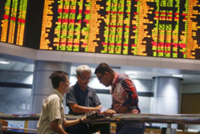Calculated approach: Collins during a television interview in New York. The Federal Reserve Bank of Boston president says she sees no urgency to cut interest rates in the near term, given elevated inflation and the resilience of the labour market. — Bloomberg
NEW YORK: Bond investors, who were torched yet again by robust economic data, now want clear and conclusive proof that US Federal Reserve (Fed) interest rate cuts are imminent before making any more big bullish wagers.
US yields surged to their highest levels of the year last week after traders were dealt the nasty surprise of a third straight month of sticky inflation.
The market shock was accompanied by a wave of fresh short positions, with a growing camp of investors turning wary. Weak demand at the Treasury’s recent sales of long-term bonds provided even more evidence of bearish sentiment.
“The shorts have the treasury market now,” said Andrew Brenner, head of international fixed income at NatAlliance Securities LLC. “We need to have numbers that back up the idea that rates need to be lower.”
Treasuries snapped their slide last Friday, and yields fell as tensions in the Middle East spurred a flight to safety.
Iran’s unprecedented attack against Israel last Saturday added to anxieties, and yet, while any further escalation may generate demand for US government debt as a haven, the current economic backdrop is more in line with an environment of higher rates for longer and pressure on bonds.
Without convincing evidence of a change, few investors seem willing to swim against that tide.
After starting the year by pricing in as many as six rate cuts in 2024, or 1.5 percentage points of easing, traders are now doubtful there will even be a half-point of reductions.
Most Wall Street economists have dialled back forecasts as well, setting up a dour scenario for US yields, including a possible repeat of maturities breaching 5% as they did last October.
The recalibration in rate-cut expectations has been brutal for bonds. US Treasuries lost about 0.6% last week and are down some 2.6% for the year so far, according to a Bloomberg index. That’s a giveback of more than half of the 4.1% gain they posted in 2023.
Even after last Friday’s gains, the 10-year yield ended last week at 4.52%, with anticipated buying at the 4.5% level either not surfacing or at the very least not strong enough to fight the barrage of selling pressure.
“With US disinflation now stalling well above the Fed’s 2% target for three months straight, traders are acclimating to the prospect that the ‘last mile’ of disinflation is tough to achieve,” said Thierry Wizman, global currencies and interest rate strategist at Macquarie Group.
A rise in 10-year yields to 4.75% “doesn’t look like much of a stretch” given where they are now, he added.
Federal Reserve Bank of Boston president Susan Collins said last Friday that it may take more time than previously thought to gain the confidence to begin easing policy, reiterating previous views.
A day earlier, colleague New York Fed president John Williams said there was no clear need to adjust policy in the near term.
This week, investors will get a read on consumer spending with the latest retail sales report, as well as new data on how the housing market is fairing with mortgage rates still high.
Traders will also be parsing earnings from some of Wall Street’s biggest banks, with JPMorgan Chase & Co shares falling last Friday after its outlook for full-year net interest income missed expectations.
Citigroup Inc’s profits topped analysts’ estimates.
The minutes released last Wednesday from the Fed’s March gathering underscored officials’ reluctance to lower rates until they have more evidence that inflation is firmly on a path to 2%.
Consumer prices rose 3.8% in the 12 months ended in March, excluding food and energy.
Meanwhile, a growing chorus is questioning whether Fed policy is restrictive enough to crimp the labour market, despite the recent aggressive tightening cycle.
Many traders now believe the so-called neutral rate, which neither stimulates nor restricts the economy, is much higher now than in the pre-pandemic era.
Bloomberg Intelligence said: “Rate markets have repriced into new ranges following the stronger-than-expected March US consumer price report and still-neutral Fed meeting minutes.
“The market is starting to hedge rate hikes as the next policy action, but the two-year yield may be discounting more symmetric outcomes.” — Bloomberg





